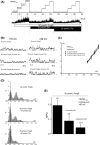Diclofenac, a nonsteroidal anti-inflammatory drug, is an antagonist of human TRPM3 isoforms
- PMID: 27433342
- PMCID: PMC4876142
- DOI: 10.1002/prp2.232
Diclofenac, a nonsteroidal anti-inflammatory drug, is an antagonist of human TRPM3 isoforms
Abstract
The effects of diclofenac (Dic), an acetic acid derivative-type nonsteroidal anti-inflammatory drug, were examined on the function of transient receptor potential (TRP) melastatin (TRPM) 3 (TRPM3) in human embryonic kidney 293 cell-line (HEK293) cells with recombinant human TRPM3 isoforms (TRPM31325, TRPM3-3, TRPM3-9, and TRPM3-S) and in a neuroblastoma cell line human neuroblastoma IMR-32 cells (IMR-32 cells) derived from human peripheral neurons. TRPM3 responses evoked by pregnenolone sulfate (PregS) were effectively inhibited by Dic in a concentration-dependent manner in Ca(2+) measurement and electrophysiological assays. The apparent IC 50 for PregS-induced Ca(2+) response of TRPM31325, TRPM3-3, and TRPM3-9 was calculated to be 18.8, 42.5, and 7.1 μmol/L, respectively. The TRPM3-dependent Ca(2+) responses evoked by nifedipine, another TRPM3 agonist, were also significantly inhibited by Dic. In contrast, aceclofenac, an acetoxymethyl analog of Dic, had no effects on PregS-induced TRPM3 responses. Constitutive channel activity of TRPM3-S without TRPM3 agonists was substantially inhibited by Dic, ruling out the possibility of interaction of Dic against TRPM3 agonists to the channel binding sites. Moreover, Dic reversibly inhibited TRPM3 single-channel activity recorded in excised outside-out patches without affecting the channel conductance. In differentiated neuronal IMR-32 cells with endogenous TRPM3, Dic inhibited PregS-evoked Ca(2+) responses with an apparent IC 50 of 17.1 μmol/L. Taken together, our findings demonstrate that Dic inhibits human TRPM3 without interacting with the channel pore.
Keywords: Diclofenac; TRPM3; neuroblastoma; pain.
Figures








Similar articles
-
Primidone inhibits TRPM3 and attenuates thermal nociception in vivo.Pain. 2017 May;158(5):856-867. doi: 10.1097/j.pain.0000000000000846. Pain. 2017. PMID: 28106668 Free PMC article.
-
Validation of impaired Transient Receptor Potential Melastatin 3 ion channel activity in natural killer cells from Chronic Fatigue Syndrome/ Myalgic Encephalomyelitis patients.Mol Med. 2019 Apr 23;25(1):14. doi: 10.1186/s10020-019-0083-4. Mol Med. 2019. PMID: 31014226 Free PMC article.
-
Naltrexone Restores Impaired Transient Receptor Potential Melastatin 3 Ion Channel Function in Natural Killer Cells From Myalgic Encephalomyelitis/Chronic Fatigue Syndrome Patients.Front Immunol. 2019 Oct 31;10:2545. doi: 10.3389/fimmu.2019.02545. eCollection 2019. Front Immunol. 2019. PMID: 31736966 Free PMC article. Clinical Trial.
-
The newest TRP channelopathy: Gain of function TRPM3 mutations cause epilepsy and intellectual disability.Channels (Austin). 2021 Dec;15(1):386-397. doi: 10.1080/19336950.2021.1908781. Channels (Austin). 2021. PMID: 33853504 Free PMC article. Review.
-
TRPM3 in the eye and in the nervous system - from new findings to novel mechanisms.Biol Chem. 2022 Mar 2;403(8-9):859-868. doi: 10.1515/hsz-2021-0403. Print 2022 Jul 26. Biol Chem. 2022. PMID: 35240732 Review.
Cited by
-
Anesthetic- and Analgesic-Related Drugs Modulating Both Voltage-Gated Na+ and TRP Channels.Biomolecules. 2024 Dec 18;14(12):1619. doi: 10.3390/biom14121619. Biomolecules. 2024. PMID: 39766326 Free PMC article. Review.
-
Primidone inhibits TRPM3 and attenuates thermal nociception in vivo.Pain. 2017 May;158(5):856-867. doi: 10.1097/j.pain.0000000000000846. Pain. 2017. PMID: 28106668 Free PMC article.
-
TRPM3 in Brain (Patho)Physiology.Front Cell Dev Biol. 2021 Feb 26;9:635659. doi: 10.3389/fcell.2021.635659. eCollection 2021. Front Cell Dev Biol. 2021. PMID: 33732703 Free PMC article. Review.
-
Sensing the heat with TRPM3.Pflugers Arch. 2018 May;470(5):799-807. doi: 10.1007/s00424-017-2100-1. Epub 2018 Jan 5. Pflugers Arch. 2018. PMID: 29305649 Free PMC article. Review.
-
Topical Treatments and Their Molecular/Cellular Mechanisms in Patients with Peripheral Neuropathic Pain-Narrative Review.Pharmaceutics. 2021 Mar 26;13(4):450. doi: 10.3390/pharmaceutics13040450. Pharmaceutics. 2021. PMID: 33810493 Free PMC article. Review.
References
-
- Alves DP, Tatsuo MA, Leite R, Duarte ID (2004). Diclofenac‐induced peripheral antinociception is associated with ATP‐sensitive K+ channels activation. Life Sci 74: 2577–2591. - PubMed
-
- Bort R, Ponsoda X, Jover R, Gomez‐Lechon MJ, Castell JV (1999). Diclofenac toxicity to hepatocytes: a role for drug metabolism in cell toxicity. J Pharmacol Exp Ther 288: 65–72. - PubMed
LinkOut - more resources
Full Text Sources
Other Literature Sources
Molecular Biology Databases
Miscellaneous

